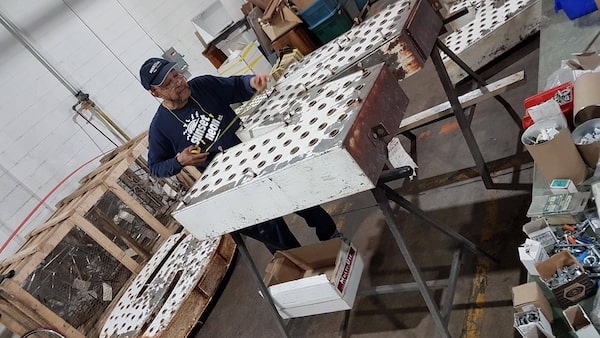
Parts of the original Sam the Record Man sign from the 1960s need to be totally replaced, while others just need a new paint job.Tony Bianchi
The original craftsmen working on the Sam the Record Man sign in the late 1960s used a paint can as the spindle of one of the giant, rotating neon records that once graced Yonge Street. (The sign originally featured just one record, but a second one was added in the 1980s.) The use of the odd, everyday item is one of the discoveries made by the team working on the restoration, a process which is revealing how the signs were originally constructed.
Ryerson University took responsibility for restoring the signs after building its Student Learning Centre on the Yonge Street heritage site that was the former home to the Sam the Record Man store – once a magnet for Toronto music lovers.
The enterprise began inside Sam Sniderman's family's radio store in 1937 but grew to become a successful record chain with 130 locations across Canada. The business eventually dwindled as CD and record sales declined, and Sam's finally shut down its Yonge Street flagship store permanently in June, 2007.
Tony Bianchi from Sunset Neon, a custom signage company, is one of the 25 craftsmen working to restore the historical signs. He spoke to The Globe and Mail about his discoveries, as well as the challenge and excitement of working on the signs that will be hoisted, this fall, onto the roof of 277 Victoria St., overlooking Yonge-Dundas Square.
What did the signs look like when you first began your work?
They looked terrible but some parts were in almost perfect condition. The original signs were made from sheet metal, which rusts over time, so much of the signs were rusted beyond repair and were not salvageable.
What does the procedure for the repair of the signs look like?
We just completed the design stage and there has been no major physical work on the signs yet, but the material has been ordered and is expected to come in at any time. We started by refurbishing the "Sam" letters that were removed and creating the neon tubes. We are also replacing all of the white neon tubes because the glass tubing has lead content and so we are replacing all of those with lead-free glass. We will be also replacing the fluorescent lamps with LED lighting.
What were some surprising things you learned about these signs?
The rust that accumulated on the sheet metal made much of the signs beyond repair but, surprisingly, the "Sam" letters, made with the same material, are almost in perfect condition. All they really need is some paint and minor cosmetic work. The other strange thing we've found so far is an old paint can which was used as a record spindle for one of the two signs.
What does the paint can tell you about how the sign was originally made?
The craftsmen who worked on the sign came up with a brilliant idea to use the paint can. In the late-1960s they had to work with whatever they had on hand. They did not have automated equipment like we do today, so they had to get creative and decided to use a paint can as a spindle. The newer sign, made in 1987 when technology had advanced a little, has a spindle, which probably cost a lot to make but works just as well as the paint can. We are going to attach the can onto the new sign.
Why is it important to save old neon signs like this?
It's like a historic building or historic artifact. These signs hold so much meaning for so many people that it would be just a shame to dispose of them and have them forgotten. Sam the Record Man had such an impact on Toronto and the music industry across the country. I think it is a great idea to preserve those memories.
Involving people who worked on the project in the past is also really important. The original sign was made by the Markle Brothers, Sam and Jack Markle, who are very elderly now. The light-flasher units, which make the neon rings of the spinning discs appear to "rotate," will be freshly reprogrammed by the brothers in order to make it so they are identical to the original. Len Black, who had blown glass for the original signs, is currently working on the project as well.
Do you remember seeing the signs in the past? What is it like to now work on restoring them?
I used to visit the store when I was younger to buy records or just go in to browse. Sam the Record Man used to be the place where everyone would go to buy records. Being in the sign industry for 40 years, this is the ultimate project. It's amazing to work on something as iconic as these signs and to restore them to their former glory and preserve the image of it. It's not often that I am able to work on something of such historical significance.
This interview has been condensed and edited.